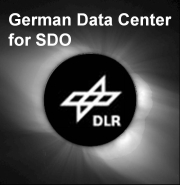Project Overview
The Solar Dynamics Observatory (SDO) is NASA's most important solar physics mission of this decade. It was launched 11th February 2010 and the three primary instruments on board are i) the Helioseismic and Magnetic Imager (HMI), ii) the Atmospheric Imaging Assembly (AIA), and iii) the Extreme ultraviolet Variability Experiment (EVE). The data will be predominantly used to learn about solar magnetic activity. SDO transmits 1-2 TB of data per day, thereby flooding the solar scientific community with high-resolution data and corresponding (higher-level) science data products. Thus, the necessity for an advanced data management system to effectively deliver rapid and simple access to users and developers throughout Germany is inevitable.
The German Aerospace Center (DLR) is providing support to operate the German Data Center for SDO (GDC-SDO) that will manage, maintain, archive and process the enormous volume of anticipated data. This is a long term commitment that commenced 1st August 2007 and the most recent funding has been granted until the end of 2020. The GDC-SDO is hosted by the Max Planck Institute for Solar System Research (MPS) in Goettingen, Germany. The data is being made available from the Joint Science Operations Center (JSOC) headquartered at Stanford University in the USA.
The GDC-SDO is also funded by the SOLARNET (High-Resolution Solar Physics Network) project, where it provides access to SDO data to the European scientific community.
The Data Record Management System (DRMS) is software developed at JSOC that is used to handle all aspects of SDO data management. NetDRMS is a specific distribution of the DRMS that is designed to run on sites external to JSOC, and furthermore, it encompasses the notion of several netDRMS locations communicating and sharing SDO data. NetDRMS is currently running at the GDC-SDO. The DRMS is built around the advanced open-source database software PostgreSQL. DRMS users communicate to the PostgreSQL database to search through metadata and also to a Storage Unit Management System (SUMS) to access the physical data. Finally, the PEGASUS workflow management system, along with the CONDOR job scheduler and GLOBUS grid technologies, will be used to automate GDC-SDO data workflows.
